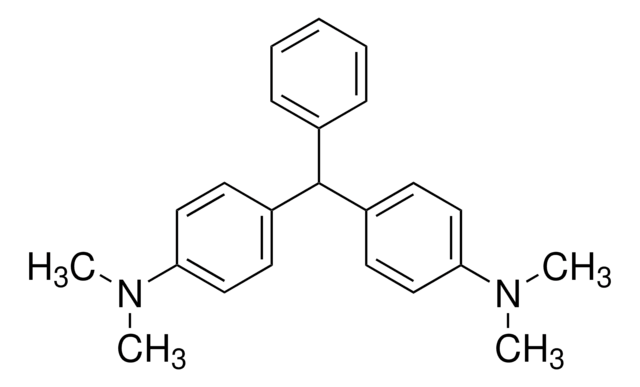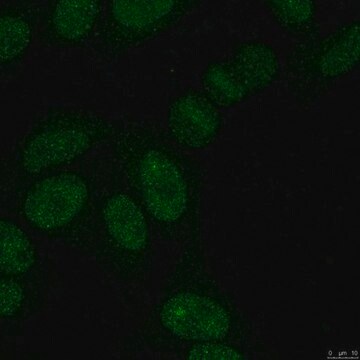MABS2071
Anti-SUMO-1 Antibody, clone 21C7
clone 21C7, from mouse
同義詞:
Small ubiquitin-related modifier 1, GAP-modifying protein 1, GMP1, SMT3 homolog 3, Sentrin, Ubiquitin-homology domain protein PIC1, Ubiquitin-like protein SMT3C, Smt3C, Ubiquitin-like protein UBL1
登入查看組織和合約定價
全部照片(1)
About This Item
分類程式碼代碼:
12352203
eCl@ss:
32160702
NACRES:
NA.41
推薦產品
生物源
mouse
抗體表格
purified immunoglobulin
抗體產品種類
primary antibodies
無性繁殖
21C7, monoclonal
物種活性
chicken, human, mouse, zebrafish, rat, Xenopus, fish
包裝
antibody small pack of 25 μg
技術
immunocytochemistry: suitable
immunofluorescence: suitable
immunohistochemistry: suitable
immunoprecipitation (IP): suitable
western blot: suitable
同型
IgG2b
NCBI登錄號
UniProt登錄號
目標翻譯後修改
unmodified
基因資訊
human ... SUMO1(7341)
一般說明
Small ubiquitin-related modifier 1 (UniProt: P63165; also known as SUMO-1, GAP-modifying protein 1, GMP1, SMT3 homolog 3, Sentrin, Ubiquitin-homology domain protein PIC1, Ubiquitin-like protein SMT3C, Smt3C, Ubiquitin-like protein UBL1) is encoded by the SUMO1 (also known as SMT3C, SMT3H3, UBL1, OK/SW-cl.43) gene (Gene ID: 7341) in human. SUMO-1 is a ubiquitin-like protein that can be covalently attached to proteins as a monomer or a lysine-linked polymer. Covalent attachment via an isopeptide bond to its substrates requires prior activation by the E1 complex SAE1-SAE2 and linkage to the E2 enzyme UBE2I, and can be promoted by E3 ligases such as PIAS1-4, RANBP2 or CBX4. This post-translational modification on lysine residues of proteins plays a crucial role in many cellular processes, such as nuclear transport, DNA replication and repair, mitosis and signal transduction. SUMO-1 can also covalently attach to the voltage-gated potassium channel KCNB1; this modulates the gating characteristics of KCNB1. Polymeric SUMO-1 chains are shown to be susceptible to polyubiquitination, which functions as a signal for proteasomal degradation of modified proteins. Two isoforms of SUMO-1 have been reported that are produced by alternative splicing. Mutations in SUMO1 gene are known to cause non-syndromic orofacial cleft 10, which is a birth defect consisting of cleft lips with or without cleft palate.
特異性
Clone 21C7 detects SUMO-1 in multiple species. It targets an epitope with in 11 amino acids from the internal region.
免疫原
His-tagged full length human recombinant Small ubiquitin-related modifier 1 (SUMO-1).
應用
Anti-SUMO-1, clone 21C7, Cat. No. MABS2071, is a mouse monoclonal antibody that detects Small ubiquitin-related modifier 1 (SUMO-1) and has been tested for use in Immunocytochemistry, Immunohistochemistry, Immunofluorescence, Immunoprecipitation, and Western Blotting.
Immunohistochemistry Analysis: A representative lot detected SUMO-1 in Immunohistochemistry applications (Rogers, R.S., et. al. (2004). Chromosoma. 113(5):233-43; Costa, M.W., et. al. (2011). PLoA One. 6(9):e24812).
Immunocytochemistry Analysis: A representative lot detected SUMO-1 in Immunocytochemistry applications (Matunis, M.J., et. al. (1996). J Cell Biol. 135(6 Pt 1):1457-70; Zhang, X.D., et. al. (2008). Mol Cell. 29(6):729-41).
Immunoprecipitation Analysis: A representative lot immunopprecipitated SUMO-1 in Immunoprecipitation applications (Costa, M.W., et. al. (2011). PLoA One. 6(9):e24812; Becker, J., et. al. (2013). Nat Struct Mol Biol. 20(4):525-31; Girach, F., et. al. (2013). Cell Rep. 5(5):1294-301; Chanda, A., et. al. (2017). PLoS One. 12(5):e0177639).
Western Blotting Analysis: A representative lot detected SUMO-1 in Western Blotting applications (Zhang, X.D., et. al. (2008). Mol Cell. 29(6):729-41; Matunis, M.J., et. al. (1996). J Cell Biol. 135(6 Pt 1):1457-70; Rogers, R.S., et. al. (2004). Chromosoma. 113(5):233-43; Costa, M.W., et. al. (2011). PLoA One. 6(9):e24812; Becker, J., et. al. (2013). Nat Struct Mol Biol. 20(4):525-31).
Immunofluorescence Analysis: A representative lot detected SUMO-1 in Immunofluorescence applications (Girach, F., et. al. (2013). Cell Rep. 5(5):1294-301; Rogers, R.S., et. al. (2004). Chromosoma. 113(5):233-43; Matunis, M.J., et. al. (1996). J Cell Biol. 135(6 Pt 1):1457-70).
Immunocytochemistry Analysis: A representative lot detected SUMO-1 in Immunocytochemistry applications (Matunis, M.J., et. al. (1996). J Cell Biol. 135(6 Pt 1):1457-70; Zhang, X.D., et. al. (2008). Mol Cell. 29(6):729-41).
Immunoprecipitation Analysis: A representative lot immunopprecipitated SUMO-1 in Immunoprecipitation applications (Costa, M.W., et. al. (2011). PLoA One. 6(9):e24812; Becker, J., et. al. (2013). Nat Struct Mol Biol. 20(4):525-31; Girach, F., et. al. (2013). Cell Rep. 5(5):1294-301; Chanda, A., et. al. (2017). PLoS One. 12(5):e0177639).
Western Blotting Analysis: A representative lot detected SUMO-1 in Western Blotting applications (Zhang, X.D., et. al. (2008). Mol Cell. 29(6):729-41; Matunis, M.J., et. al. (1996). J Cell Biol. 135(6 Pt 1):1457-70; Rogers, R.S., et. al. (2004). Chromosoma. 113(5):233-43; Costa, M.W., et. al. (2011). PLoA One. 6(9):e24812; Becker, J., et. al. (2013). Nat Struct Mol Biol. 20(4):525-31).
Immunofluorescence Analysis: A representative lot detected SUMO-1 in Immunofluorescence applications (Girach, F., et. al. (2013). Cell Rep. 5(5):1294-301; Rogers, R.S., et. al. (2004). Chromosoma. 113(5):233-43; Matunis, M.J., et. al. (1996). J Cell Biol. 135(6 Pt 1):1457-70).
Research Category
Signaling
Signaling
品質
Evaluated by Western Blotting in HCT116 cell lysate.
Western Blotting Analysis: 4 µg/mL of this antibody detected SUMO-1 in HCT116 cell lysate.
Western Blotting Analysis: 4 µg/mL of this antibody detected SUMO-1 in HCT116 cell lysate.
標靶描述
~17 kDa observed; 11.56 kDa calculated. SUMO-1/RanGAP1 band is observed AT ~ 75 kDa Uncharacterized bands may be observed in some lysate(s).
外觀
Protein G purified
Format: Purified
Purified mouse monoclonal antibody IgG2b in buffer containing 0.1 M Tris-Glycine (pH 7.4), 150 mM NaCl with 0.05% sodium azide.
儲存和穩定性
Stable for 1 year at 2-8°C from date of receipt.
其他說明
Concentration: Please refer to lot specific datasheet.
免責聲明
Unless otherwise stated in our catalog or other company documentation accompanying the product(s), our products are intended for research use only and are not to be used for any other purpose, which includes but is not limited to, unauthorized commercial uses, in vitro diagnostic uses, ex vivo or in vivo therapeutic uses or any type of consumption or application to humans or animals.
未找到適合的產品?
試用我們的產品選擇工具.
分析證明 (COA)
輸入產品批次/批號來搜索 分析證明 (COA)。在產品’s標籤上找到批次和批號,寫有 ‘Lot’或‘Batch’.。
我們的科學家團隊在所有研究領域都有豐富的經驗,包括生命科學、材料科學、化學合成、色譜、分析等.
聯絡技術服務








